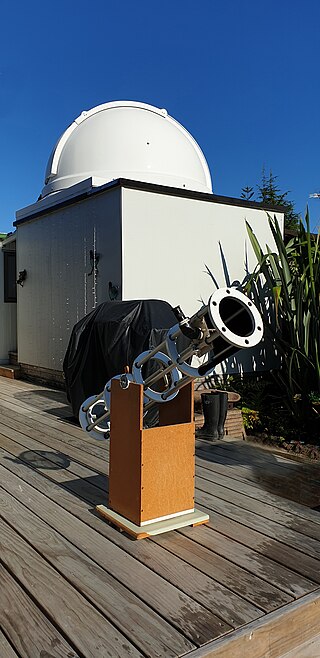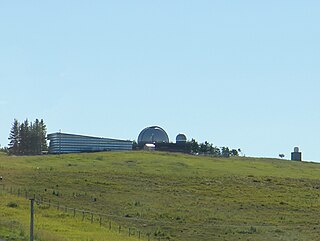
Aoraki / Mount Cook National Park is a national park located in the central-west of the South Island of New Zealand. It was established in October 1953 and takes its name from the highest mountain in New Zealand, Aoraki / Mount Cook. The area of the park is 707 km2 (273 sq mi), and it shares a border with Westland Tai Poutini National Park along the Main Divide of the Southern Alps. The national park consists of reserves that were established as early as 1885 to protect the area's significant landscape and vegetation. Glaciers cover 40% of the park, including the county's largest glacier, Haupapa / Tasman Glacier. In 1990, the park was included in the area designated as the Te Wāhipounamu World Heritage Site. The park is managed by the Department of Conservation (DOC) alongside Ngāi Tahu, the iwi who are mana whenua in the region.

Stardome Observatory & Planetarium is a public astronomical observatory and planetarium situated in Maungakiekie/One Tree Hill Domain in Auckland, New Zealand.

The Mackenzie Basin, popularly and traditionally known as the Mackenzie Country, is an elliptical intermontane basin located in the Mackenzie and Waitaki Districts, near the centre of the South Island of New Zealand. It is the largest such basin in New Zealand. Historically famous mainly for sheep farming, the sparsely populated area is now also a popular tourism destination.

Siding Spring Observatory near Coonabarabran, New South Wales, Australia, part of the Research School of Astronomy & Astrophysics (RSAA) at the Australian National University (ANU), incorporates the Anglo-Australian Telescope along with a collection of other telescopes owned by the Australian National University, the University of New South Wales, and other institutions. The observatory is situated 1,165 metres (3,822 ft) above sea level in the Warrumbungle National Park on Mount Woorat, also known as Siding Spring Mountain. Siding Spring Observatory is owned by the Australian National University (ANU) and is part of the Mount Stromlo and Siding Spring Observatories research school.

Lake Pukaki is the largest of three roughly parallel alpine lakes running north–south along the northern edge of the Mackenzie Basin on New Zealand's South Island. The others are Lakes Tekapo and Ōhau. All three lakes were formed when the terminal moraines of receding glaciers blocked their respective valleys, forming moraine-dammed lakes. The Alps2Ocean mountain bike trail follows the edge of Lake Pukaki for part of its length.

Lake Tekapo is the second-largest of three roughly parallel lakes running north–south along the northern edge of the Mackenzie Basin in the South Island of New Zealand. It covers an area of 83 km2 (32 sq mi) and is at an altitude of 710 m (2,330 ft) above sea level.

Lake Tekapo is a small township located at the southern end of the lake of the same name in the inland South Island of New Zealand. It had 558 residents according to the 2018 census, being one of five settlements in the sparsely populated Mackenzie Basin.

Mackenzie District is a local government district on New Zealand's South Island, administered by the Mackenzie District Council. It is part of the larger Canterbury Region. The region takes its name from the Mackenzie Basin, an elliptical intermontane basin which covers much of inland Canterbury.

Gravitational microlensing is an astronomical phenomenon caused by the gravitational lens effect. It can be used to detect objects that range from the mass of a planet to the mass of a star, regardless of the light they emit. Typically, astronomers can only detect bright objects that emit much light (stars) or large objects that block background light. These objects make up only a minor portion of the mass of a galaxy. Microlensing allows the study of objects that emit little or no light.

Farm Cove Observatory (FCO) was an amateur astronomical observatory in Pakuranga, Auckland, New Zealand, where Jennie McCormick discovered the main-belt asteroid 386622 New Zealand in September 2009.

OGLE-2005-BLG-390Lb is a super-Earth exoplanet orbiting OGLE-2005-BLG-390L, a star 21,500 ± 3,300 light-years from Earth near the center of the Milky Way, making it one of the most distant planets known. On January 25, 2006, Probing Lensing Anomalies NETwork/Robotic Telescope Network (PLANET/Robonet), Optical Gravitational Lensing Experiment (OGLE), and Microlensing Observations in Astrophysics (MOA) made a joint announcement of the discovery. The planet does not appear to meet conditions presumed necessary to support life.

The Optical Gravitational Lensing Experiment (OGLE) is a Polish astronomical project based at the University of Warsaw that runs a long-term variability sky survey (1992–present). The main goals are the detection and classification of variable stars, discovery of microlensing events, dwarf novae, and studies of the structure of the Galaxy and the Magellanic Clouds. Since the project began in 1992, it has discovered a multitude of extrasolar planets, together with the first planet discovered using the transit method (OGLE-TR-56b) and gravitational microlensing. The project has been led by professor Andrzej Udalski since its inception.
RoboNet-1.0 was a prototype global network of UK-built 2-metre robotic telescopes, the largest of their kind in the world, comprising the Liverpool Telescope on La Palma, the Faulkes Telescope North on Maui (Hawaii), and the Faulkes Telescope South in Australia, managed by a consortium of ten UK universities under the lead of Liverpool John Moores University. For the technological aims of integrating a global network to act effectively as a single instrument, and maximizing the scientific return by applying the newest developments in e-Science, RoboNet adopted the intelligent-agent architecture devised and maintained by the eSTAR project.
The Microlensing Follow-Up Network is an informal group of observers who monitor high magnification gravitational microlensing events in the Milky Way's Galactic Bulge. Its goal is to detect extrasolar planets via microlensing of the parent star by the planet. μFUN is a follow-up network - they monitor microlensing events identified by survey groups such as OGLE and Microlensing Observations in Astrophysics (MOA).

The Rothney Astrophysical Observatory (RAO) is an astronomical observatory located near the hamlet of Priddis, Alberta, Canada, about 20 kilometres (12 mi) southwest of Calgary. The observatory is owned and operated by the University of Calgary (UC), and was dedicated in 1972. The facility is used for research, undergraduate and graduate teaching, and public outreach. Research performed at the RAO included a variable star search program, follow-up observations of variable star discoveries, and detailed investigation of binary stars. An outstanding minor planet search program was also performed with comet discoveries by Rob Cardinal. The RAO is a link in the Skynet Robotic Telescope Network.
In astronomy, the MACHO Project was an observational search during 1992-1999 for dark matter around our Milky Way galaxy in the form of hypothetical Massive Compact Halo Objects (MACHOs), using the method of gravitational microlensing. It was one of three first-generation microlensing searches started in the early 1990s, the others being the independent EROS and OGLE projects. The MACHO project was carried out by a team of US and Australian astronomers; observations used the 1.27-metre (50-inch) telescope at the Mount Stromlo Observatory near Canberra, which was dedicated to the project full-time from 1992 until 1999. The project did not solve the dark matter problem, but placed important upper limits on the fraction of dark matter in MACHOs across a wide range of masses, and achieved several notable discoveries in the field of microlensing, and new results on several classes of variable stars.
Norman Jack Rumsey was a New Zealand designer of optical systems.
Mount Kent Observatory near Toowoomba, in the Darling Downs region of Queensland, Australia, is an observatory owned and operated by the University of Southern Queensland (UniSQ). It is the only professional astronomical research observatory in the state of Queensland. Mount Kent hosts the four MINERVA-Australis exoplanet-finding telescopes, three SONG telescopes for asteroseismology and stellar astrophysics, two 'Shared Skies' telescopes, and a USQ-Louisville telescope.
William John Tobin was a British–New Zealand astronomer and academic. In the 2019 United Kingdom general election he stood as an independent candidate against Boris Johnson in the Uxbridge and South Ruislip constituency. As he had not resided in Britain for more than 15 years he was ineligible to vote but eligible to stand as a candidate. He focused his campaign on voting rights using the slogan "Don't vote for Tobin, let Tobin vote". He gained five votes.

The Aoraki Mackenzie International Dark Sky Reserve is an area of 4,367 km2 (1,686 sq mi) that was designated as an International Dark Sky Reserve by the International Dark-Sky Association in June 2012. The reserve is located in the Mackenzie District in the South Island of New Zealand. At the time of the designation in 2012, the reserve was the largest in the world, and the only reserve of its type in the Southern Hemisphere.
















